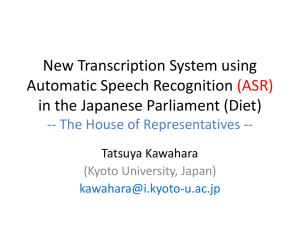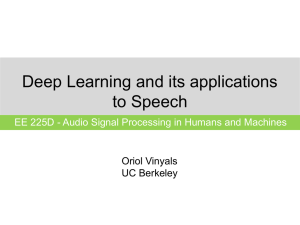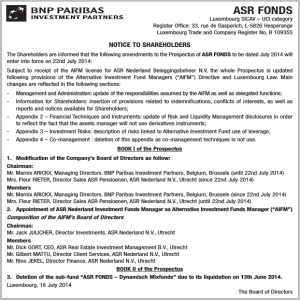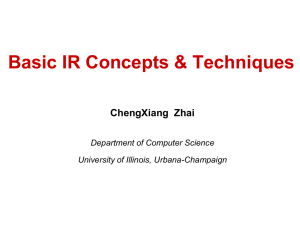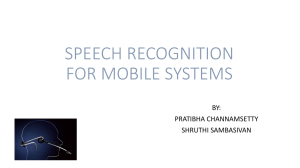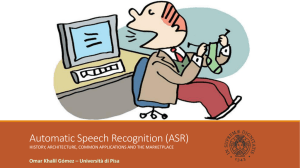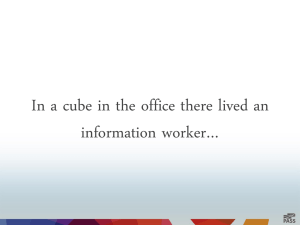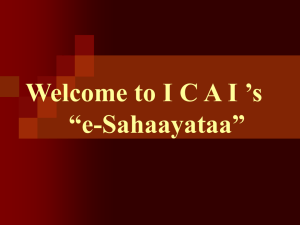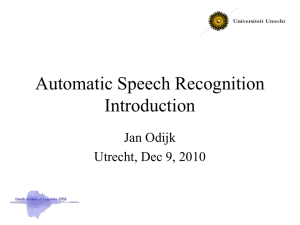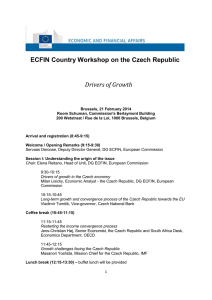Image and Sound Retrieval - University of Maryland Institute for
advertisement
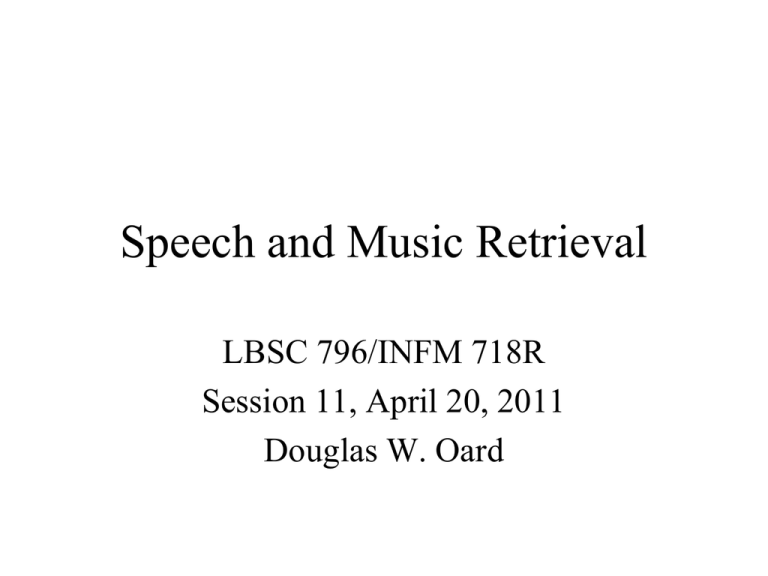
Speech and Music Retrieval LBSC 796/INFM 718R Session 11, April 20, 2011 Douglas W. Oard Audio Indexing • Music • Sounds • Speech Encoding Audio • Nyquist theorem: sampling rate • Channel characteristics – Bandpass – Amplitude resolution • Compression – Lossless – Perceptually-based lossy (e.g., .mp3) User-Centered Music Retrieval • User types: – Casual • name that tune, playlist generation, query by humming, … – Professional • Instrument detection, timbre, … – Scholar • Content types: – Score – Performance Shazam • Spectrogram – Time vs. frequency plot of intensity • Peak filter – Local maxima of intensity • Difference coding – Rate of frequency change over time • Convolution – Sliding correlation Muscle Fish Audio Retrieval • Compute 4 acoustic features for each time slice – Pitch, amplitude, brightness, bandwidth • Segment at major discontinuities – Find average, variance, and smoothness of segments • Store pointers to segments in 13 sorted lists – Use a commercial database for proximity matching • 4 features, 3 parameters for each, plus duration – Then rank order using statistical classification • Display file name and audio New Zealand Melody Index • Index musical tunes as contour patterns – Rising, descending, and repeated pitch – Note duration as a measure of rhythm • Users sing queries using words or la, da, … – Pitch tracking accommodates off-key queries • Rank order using approximate string match – Insert, delete, substitute, consolidate, fragment • Display title, sheet music, and audio Contour Matching Example • “Three Blind Mice” is indexed as: – *DDUDDUDRDUDRD • * represents the first note • D represents a descending pitch (U is ascending) • R represents a repetition (detectable split, same pitch) • My singing produces: – *DDUDDUDRRUDRR • Approximate string match finds 2 substitutions Spoken Word Collections • Broadcast programming – News, interview, talk radio, sports, entertainment • Scripted stories – Books on tape, poetry reading, theater • Spontaneous storytelling – Oral history, folklore • Incidental recording – Speeches, oral arguments, meetings, phone calls Some Statistics ~250,000 hours of oral history in British Library >4,000 radio stations webcasting ~35 million hours per year ~100 billion hours of phone calls each year Economics of the Web Storage Text in 1995 Speech in 2003 300K 1.5M 250K 30M 100% 20% 10% 38% Lycos Yahoo SpeechBot SingingFish (words per $) Internet Backbone (simultaneous users) Modem Capacity (% utilization) Display Capability (% US population) Search Systems Speech Retrieval Approaches • Controlled vocabulary indexing • Ranked retrieval based on associated text Automatic feature-based indexing • Social filtering based on other users’ ratings Supporting Information Access Source Selection Search System Query Formulation Query Search Query Reformulation and Relevance Feedback Ranked List Selection Recording Examination Source Reselection Recording Delivery Description Strategies • Transcription – Manual transcription (with optional post-editing) • Annotation – Manually assign descriptors to points in a recording – Recommender systems (ratings, link analysis, …) • Associated materials – Interviewer’s notes, speech scripts, producer’s logs • Automatic – Create access points with automatic speech processing Detectable Speech Features • Content – Phonemes, one-best word recognition, n-best • Identity – Speaker identification, speaker segmentation • Language – Language, dialect, accent • Other measurable parameters – Time, duration, channel, environment How Speech Recognition Works • Three stages – What sounds were made? • Convert from waveform to subword units (phonemes) – How could the sounds be grouped into words? • Identify the most probable word segmentation points – Which of the possible words were spoken? • Based on likelihood of possible multiword sequences • These can be learned from “training data” – Hill-climbing sequence models • (a “Hidden Markov Model”) Using Speech Recognition Phone n-grams Phone Detection Transcription dictionary Language model Phone lattice Word Construction Word lattice Word Selection One-best transcript Words Phone Lattice Phoneme Trigrams • Manage -> m ae n ih jh – Dictionaries provide accurate transcriptions • But valid only for a single accent and dialect – Rule-base transcription handles unknown words • Index every overlapping 3-phoneme sequence – m ae n – ae n ih – n ih jh Cambridge Video Mail Retrieval • Translate queries to phonemes with dictionary – Skip stopwords and words with 3 phonemes • Find no-overlap matches in the lattice – Queries take about 4 seconds per hour of material • Vector space exact word match – No morphological variations checked – Normalize using most probable phoneme sequence • Select from a ranked list of subject lines Key Results from TREC/TDT • Recognition and retrieval can be decomposed – Word recognition/retrieval works well in English • Retrieval is robust with recognition errors – Up to 40% word error rate is tolerable • Retrieval is robust with segmentation errors – Vocabulary shift/pauses provide strong cues Competing Demands on the Interface • Query must result in a manageable set – But users prefer simple query interfaces • Selection interface must show several segments – Representations must be compact, but informative • Rapid examination should be possible – But complete access to the recordings is desirable BBN Radio News Retrieval AT&T Radio News Retrieval MIT “Speech Skimmer” Comparison with Text Retrieval • Detection is harder – Speech recognition errors • Selection is harder – Date and time are not very informative • Examination is harder – Linear medium is hard to browse – Arbitrary segments produce unnatural breaks A Richer View of Speech • Speaker identification – Known speaker and “more like this” searches – Gender detection for search and browsing • Topic segmentation – Vocabulary shift, cue words – More natural breakpoints for browsing • Speaker segmentation – Visualize turn-taking behavior for browsing – Classify turn-taking patterns for searching Speaker Identification • Gender – Classify speakers as male or female • Identity – Detect speech samples from same speaker – To assign a name, need a known training sample • Speaker segmentation – Identify speaker changes – Count number of speakers Visualizing Turn-Taking Broadcast News Retrieval Study • NPR Online Manually prepared transcripts Human cataloging • SpeechBot Automatic Speech Recognition Automatic indexing NPR Online SpeechBot Study Design • Seminar on visual and sound materials – Recruited 5 students • After training, we provided 2 topics – 3 searched NPR Online, 2 searched SpeechBot • All then tried both systems with a 3rd topic – Each choosing their own topic • Rich data collection – Observation, think aloud, semi-structured interview • Model-guided inductive analysis – Coded to the model with QSR NVivo Criterion-Attribute Framework Relevance Criteria Topicality Story Type Authority Associated Attributes NPR Online Story title Brief summary Audio Detailed summary Speaker name Audio Detailed summary Short summary Story title Program title Speaker name Speaker’s affiliation SpeechBot Detailed summary Brief summary Audio Highlighted terms Audio Program title Lessons Learned from the MALACH Project Applying New Technologies to Improve Intellectual Access to Large Oral History Collections Douglas W. Oard College of Information Studies and Institute for Advanced Computer Studies Outline • The MALACH Project • Learning from our users • Evaluating new access technologies • What’s left to do? Indexing Options • Transcript-based (e.g., NASA) – Manual transcription, editing by interviewee • Thesaurus-based (e.g., Shoah Foundation) – Manually assign descriptors to points in interview • Catalog-based (e.g., British Library) – Catalog record created from interviewer’s notes • Speech-based (MALACH) – Create access points with speech processing Supporting the Search Process Source Selection Search System Query Formulation Query Search Query Reformulation and Relevance Feedback • Speech Processing • Computational Linguistics • Information Retrieval • Information Seeking • Human-Computer Interaction • Digital Archives Ranked List Selection Recording Examination Source Reselection Recording Delivery The MALACH Project Topic Segmentation Categorization Extraction Translation Language Technology Speech Technology English Czech Russian Slovak Search Technology Interactive Search Systems Test Collection Interface Development User Studies The MALACH/CLEF Team • • • • USA USC (Shoah Foundation) – Sam Gustman IBM TJ Watson – Bhuvana Ramabhadran – Martin Franz U. Maryland – Doug Oard – Dagobert Soergel Johns Hopkins – Zak Schafran Asia • IBM India – Nanda Kambhatha • • • • • Europe U. Cambridge (UK) – Bill Byrne Charles University (CZ) – Jan Hajic – Pavel Pecina U. West Bohemia (CZ) – Josef Psutka – Pavel Ircing Dublin City University (IE) – Gareth Jones Budapest U Tech+Econ (HU) – Tibor Fegyo – Peter Mihajlik • Spontaneous conversational speech • Digitized • Large – 116,000 hours; 52,000 people; 32 languages • Full-description segment indexing – 10,000 hours, ~150,000 topical segments • Real users Interview Excerpt • Content characteristics – Domain-specific terms – Named entities • Audio characteristics – Accented (this one is unusually clear) – Two channels (interviewer / interviewee) • Dialog structure – Interviewers have different styles Outline • The MALACH Project Learning from our users • Evaluating new access technologies • What’s left to do? Who Uses the Collection? Discipline • • • • • • • • History Linguistics Journalism Material culture Education Psychology Political science Law enforcement Products • • • • • • • • Book Documentary film Research paper CDROM Study guide Obituary Evidence Personal use Based on analysis of 280 access requests 2002-2003 Observational Studies 8 independent searchers – – – – – – – Holocaust studies (2) German Studies History/Political Science Ethnography Sociology Documentary producer High school teacher 8 teamed searchers – All high school teachers Thesaurus-based search Rich data collection – – – – – Intermediary interaction Semi-structured interviews Observer’s notes Participant notes Screen capture Qualitative analysis – Theory-guided coding – Abductive reasoning Information Need Scholars: Relevance Criteria Query S1 Relevance Judgment Query Reformulation Situation n Browse Only - Accessibility (6%) - Richness (6%) - Emotion (3%) - Duration (2%) - Miscellaneous (3%) Gap n G1 Query & Browse - Topicality (76%) - Comprehensibility (2%) - Novelty of content (1%) - Acquaintance (1%) Action n A1 Scholars: Topic Types Person Place Event/Experience Subject Organization/Group Time Frame Object 0 20 40 60 80 100 120 140 Total mentions 6 Scholars, 1 teacher, 1 movie producer, working individually Basis for Query Reformulation • Searcher’s prior knowledge (31%) • Viewing an interview or segment (20%) • Help from an intermediary (15%) Total • • • • Thesaurus (13%) Assigned descriptors (12%) Pre-interview questionnaire (6%) Result set size (4%) Of 40% From Classification Teachers: Search Strategies • Scenario-guided searching – Look for experiences that would reflect themes • Proxy searching – Descriptors & interview questions • Browsing – Listened to testimonies for inspiration – Used thesaurus for ideas and orientation Iterating Searching & Planning Group discussions clarify themes and define activities, which hone teachers’ criteria Clarify themes & define lessons “Yesterday in my search, I just felt like I was kind of going around in the dark. But that productive writing session really directed my search.” Search & view testimony Testimonies give teachers ideas on what to discuss in the classroom (topic) and how to introduce it (activity). “We actually looked at the testimonies that we found before we started writing the lesson ... We really started with the testimony and built our lesson around it.” Teachers: Relevance Criteria • Relevant to teaching content/ method – – – – – – A: Relationship to theme B: As part of broader curriculum C: Characteristics of the story D: Relationship of story to student E: Represents different populations F: Characteristics of Oral History • Appropriateness – Developmental – Acceptability to stakeholders • Length-to-contribution ratio • Technical production quality • • • B: Relates to other schoolwork B: Variety for the classroom B: Vocabulary • • C: Positive Message for Students C: Role of Interviewee in Holocaust Events • • • D: Students connect with passage D: Students identify with interviewee D: Radical difference from students’ reality • • E: Age of interviewee at time of events E: Race • • • • • F: Expressive power F: Language & verbal expression F: Nonverbal Communication F: Diction F: Flow of interview Tie Into Curriculum • Relates to other school work “I am dealing with the Holocaust through literature. You know, Night, Anne Frank’s diaries … I would very much like to see [segments] that specifically relate to various pieces of literature.” • Suggests: – Query by published example –Using vocabulary lists to prime ASR Linking Students to a Story • Students identify with interviewee “Here she is, this older lady, but she became a 16-year-old girl when she was talking. I saw her in her school uniform on the day of graduation. She was so proud of the way she looked, and she felt so sophisticated.” • Suggests – Demographic search constraints – Indexing characteristics, not just words Curriculum & Standards U.S. History – Civil Rights Objectives “make the connection- there are survivors … who went on to teach college classes in black schools in the south” Holocaust experience for Jews & other victim groups; Racial and ethnic discrimination in U.S. Lesson Plan Topics African American soldiers; Survivor perspectives on Civil Rights movement Search Topics Segments for Students Apply Relevance Criteria & Select Segments Developing Relevance Criteria 2006 Observational Study (Teachers) User Study Limitations • Generalization - Exploratory rather than comparative - Results influenced by system and domain • Limited number of study participants - Insufficient to observe group differences • Lack of prior experience with the system - Experienced users may behave differently Outline • The MALACH Project • Learning from our users Evaluating new access technologies • What’s left to do? English Word Error Rate (%) English Transcription Accuracy 0 10 20 ASR2006A ASR2003A 30 40 50 60 70 ASR2004A 80 90 100 Jan02 Jul02 Jan03 Jul03 Jan04 Jul04 Jan05 Jul05 Jan06 Training: 200 hours from 800 speakers Speech Retrieval Evaluations • 1996-1998: TREC SDR – EN broadcast news / EN queries • 1997-2004: TDT – EN+CN+AR broadcast news / Query by example • 2003-2004: CLEF CL-SDR – EN broadcast news / Many query languages • 2005-2007: CLEF CL-SR – EN+CZ interviews / Many query languages English Test Collection Design Query Formulation Speech Recognition Boundary Detection Content Tagging Automatic Search Interactive Selection English Test Collection Design Interviews Topic Statements Training: 63 topics Evaluation: 33 topics Query Formulation Speech Recognition Automatic: 25% interview-tuned 40% domain-tuned Boundary Detection Manual: Automatic Search Topic boundaries Content Tagging Manual: ~5 Thesaurus labels Synonyms/broader terms Person names 3-sentence summaries Automatic: Thesaurus labels Synonyms/broader terms Ranked Lists Evaluation Mean Average Precision Relevance Judgments 2006/07 CL-SR English Collection • 8,104 topically-coherent segments – 297 English interviews – Known-boundary condition (“Segments”) – Average 503 words/segment • 96 topics – Title / Description / Narrative – 63 training + 33 evaluation – 6 topic languages (CZ, DE, EN, FR, NL, SP) • Relevance judgments – Search-guided + “highly ranked” (pooled) • Distributed to track participants by ELDA <DOC> <DOCNO> <INTERVIEWDATA> <NAME> <MANUALKEYWORD> <SUMMARY> <ASRTEXT2003A> <ASRTEXT2004A> <ASRTEXT2006A> <ASRTEXT2006B> <AUTOKEYWORD2004A1> <AUTOKEYWORD2004A2> Supplementary Resources • Thesaurus (Included in the test collection) ~3,000 core concepts • Plus alternate vocabulary + standard combinations ~30,000 location-time pairs, with lat/long Is-a, part-whole, “entry vocabulary” • Digitized speech .mp2 or .mp3 • In-domain expansion collection (MALACH) 186,000 scratchpad + 3-sentence summaries Number of Assigned Thesaurus Terms Mean Manually Assigned Thesaurus Terms Mean End of Interview Sequence-Based Classification Temporal Label Weights (TLW) (Based on Absolute Position) Time-Shifted Classification (TSC) (Based on Relative Position) Seg 1: “I was born in Berlin …” Seg 2: “My playmates included …” Seg 3: “Later, we moved to Munich …” Seg 4: “That’s when things started to …” Seg 1 Seg 2 Seg 3 Seg 4 ASR ASR ASR ASR Thesaurus Terms Sequence Modeling Results (part-whole) (part-whole) (is-a) (is-a) Clipped R-Precision 0.3 0.2 0.1 0.0 Geo-Time Geo-Time "Term" parent kNN Geo-Time "Type" parent kNN+TSC Concept kNN+TLW Concepts "Term" parent kNN+Both Concept "Type" parent An English Topic Number: 1148 Title: Jewish resistance in Europe Description: Provide testimonies or describe actions of Jewish resistance in Europe before and during the war. Narrative: The relevant material should describe actions of only- or mostly Jewish resistance in Europe. Both individual and group-based actions are relevant. Type of actions may include survival (fleeing, hiding, saving children), testifying (alerting the outside world, writing, hiding testimonies), fighting (partisans, uprising, political security) Information about undifferentiated resistance groups is not relevant. The 118 CL-SR Topics 38 2005 English Training 25 2005 English Evaluation 28 2006 Czech Evaluation + 41 2007 Czech Evaluation 33 13 9 2006/07 English Czech Unused Evaluation Safety 1 2006 Czech Evaluation + 3 2007 Czech Evaluation 5-level Relevance Judgments Binary qrels • “Classic” relevance (to “food in Auschwitz”) Direct Indirect Knew food was sometimes withheld Saw undernourished people • Additional relevance types Context Intensity of manual labor Comparison Food situation in a different camp Pointer Mention of a study on the subject English Assessment Process • Search-guided – Iterate topic research/query formulation/judging • Grad students in History, trained by librarians – Essential for collection reuse with future ASR – Done between topic release and submission • Highly-ranked (=“Pooled”) – Same assessors (usually same individual) – Pools formed from two systems per team • Top-ranked documents (typically 50) • Chosen in order recommended by each team • Omitting segments with search-guided judgments Quality Assurance • 14 topics independently assessed – 0.63 topic-averaged kappa (over all judgments) – 44% topic-averaged overlap (relevant judgments) – Assessors later met to adjudicate • 14 topics assessed and then reviewed – Decisions of the reviewer were final Assessor Agreement (2004) 1.0 (2122) (1592) Overall Direct (184) (775) Indirect Context (283) (235) Kappa 0.8 0.6 0.4 0.2 0.0 Comparison Pointer Relevance Type 44% topic-averaged overlap for Direct+Indirect 2/3/4 judgments 14 topics, 4 assessors in 6 pairings, 1806 judgments 0 2361 2400 1877 1850 2264 2055 2367 1979 2232 2404 2358 2265 2364 2006 2224 1871 2185 1897 2213 2198 2384 1829 1843 2253 2012 1188 1628 1630 1330 1427 1159 1279 1321 1554 1337 1332 1424 1179 1259 1414 1446 1187 1508 1192 1429 1310 1620 1605 1286 14312 1663 1225 1311 1647 1181 15602 1587 2000 1288 15601 1166 14313 1185 1341 1668 1592 1282 1133 1624 1173 1325 1345 1623 1746 1551 English Relevance Judgments 1600 Non-relevant 2005 Evaluation Topics (25) Relevant 1400 1200 1000 800 600 400 200 2005 Training Topics (38) Unused (12) CLEF-2006 CL-SR Overview • 2 tasks: English segments, Czech start times – Max of 5 “official” runs per team per task – Baseline English run: ASR / English TD topics • 7 teams / 6 countries – – – – – – Canada: Ottawa (EN, CZ) Czech Republic: West Bohemia (CZ) Ireland: DCU (EN) Netherlands: Twente (EN) Spain: Alicante (EN), UNED (EN) USA: Maryland (EN, CZ) 2006 English Results Man Uninterpolated Average Precision 0.10 0.08 0.06 0.04 0.02 0.00 DCU Ottawa Maryland Twente UNED Alicante Contributions by Assessment Type 300 Both Search-Guided Highly-Ranked 250 200 150 100 50 2185 2198 2253 2404 1829 1850 2400 2367 2265 1843 2055 2364 1877 1897 1871 2012 1979 2213 2224 2232 2264 2384 2358 2006 2361 0 2005 Evaluation topics, Binary relevance Search-Guided Rankings (2005) 0.35 Search-Guided Only 0.30 0.25 0.20 0.15 0.10 0.05 0.00 0.00 0.05 0.10 0.15 0.20 0.25 0.30 0.35 Search-Guided + Highly Ranked Mean uninterpolated average precision, 35 Official CLEF-2005 runs, 25 evaluation topics Highly-Ranked Rankings (2005) 0.35 Highly Ranked Only 0.30 0.25 0.20 0.15 0.10 0.05 0.00 0.00 0.05 0.10 0.15 0.20 0.25 0.30 0.35 Search-Guided + Highly Ranked Mean uninterpolated average precision, 35 Official CLEF-2005 runs, 25 evaluation topics Comparing Index Terms (2003) Mean Average Precision 0.5 0.4 Full Title 0.3 0.2 0.1 0.0 ASR Notes ThesTerm Summary Metadata Metadata +ASR Topical relevance, adjudicated judgments, Inquery Maryland English Results (2005) Precision@10 asr.en.qe 0.28 autokey+asr.en.qe 0.27 0.48 metadata+syn.en.qe 0.00 0.05 0.10 0.15 0.20 0.25 0.30 0.35 Mean Average Precision 25 evaluation topics, English TD queries Comparing ASR with Metadata (2005) 1 ASR Metadata Increase 0.6 0.4 0.2 0 1188 1630 2400 2185 1628 1187 1337 1446 2264 1330 1850 1414 1620 2367 2232 2000 14313 2198 1829 1181 1225 14312 1192 2404 2055 1871 1427 2213 1877 2384 1605 1179 Average Precision 0.8 CLEF-2005 training + test – (metadata < 0.2), ASR2004A only, Title queries, Inquery 3.1p1 Error Analysis (2005) ASR of % Metadata 1179 1605 2384 1877 2213 Somewhere in ASR (ASR/Metadata) Only in Metadata 1427 1871 2055 wallenberg (3/36)* rescue jews wallenberg (3/36) 2404 eichmann 1192 14312 abusive female (8/81) personnel 1225 minsko (21/71) ghetto underground 1181 1829 art auschwitz 2198 labor camps ig farben slave labor telefunken holocaust sinti roma 14313 2000 aeg 2232 2367 1620 sobibor (5/13) death camp 1414 witness eichmann jews volkswagen 1850 1330 2264 1446 1337 1187 1628 2185 2400 1630 1188 0 10 20 30 40 50 60 70 80 CLEF-2005 training + test – (metadata < 0.2), ASR2004A only, Title queries, Inquery 3.1p1 2004 Error Analysis Somewhere in ASR Results (bold occur in <35 segments) in ASR Lexicon wit jew Only in Metadata ASR % of Metadata 1630 eichmann 1188 volkswagen labor camp ig farben slave labor telefunken 1187 aeg 1628 1446 minsk ghetto underground wallenberg eichmann 1330 bomb birkeneneau 1345 sonderkommando auschwicz 1181 liber buchenwald dachau 1225 jewish kapo 14312 kindertransport 1192 ghetto life 1551 fort ontario refugee camp 1414 jewish partisan poland 1623 jew shanghai 1605 bulgaria save jew 1179 Title queries, adjudicated judgments, Inquery 0% 20% 40% 60% 80% 100% Correcting Relevant Segments ASR Corrected Metadata Uninterpolated Average Precision 1.0 0.8 0.6 0.4 0.2 0.0 1446 14312 Topic 1414 Title+Description+Narrative queries Other Languages WER [%] 30 34.49% 35.51% 38.57% + stand.+LMTr+TC + adapt. 41.15% 40 + standard. 45.91% 100h + LMTr + LMTr+TC 45.75% + stand.+LMTr+TC 50.82% 84h + LMTr 50 40.69% 50% 100h + LMTr 25h 57.92% 45h + LMTr 60 66.07% 70 20h + LMTr Czech 10/01 4/02 Russian 10/02 4/03 Polish Slovak 10/03 4/04 10/04 Hungarian 4/05 10/05 4/06 10/06 2006: Czech Test Collection • Two sets of speech recognition transcripts – Each with both channels recognized • Queries in Czech or (for CLIR) English • Unknown-boundary evaluation measure – Based only on passage start times – Start and end time assessments available Standard Resources for Czech • Brain-dead automatic segmentation – 400-word passages, with 67% overlap – Start time used as DOCNO • Prague Dependency Treebank (LDC) – Czech/English translation lexicon • Includes precompiled morphology and probabilities – Czech morphology • For both formal and colloquial • Partially translated thesaurus – Most commonly used terms, single translation 335 Seen 22 Unseen … 297 IR Eval … 800 ASR Train … English … Czech Interview Usage Unseen Seen ASR Train 0 30 60 90 120 Minutes from interview start 150 180 Czech Relevance Assessment • Czech subject experts assessors – New assessment system for unsegmented audio – 2 assessor training topics available for debugging • Search-guided assessment run in advance – Search based on onset marks + ASR results – Summaries from translated thesaurus + ASR • Highly-ranked after run submission failed – Time-base misalignment made this less useful Czech Assessment System Czech Relevant Passages Search Guided Highly Ranked Relevant Passages 100 80 60 40 20 1166 1288 1225 1431 1630 2198 1310 1181 3018 1187 1311 1321 1663 1620 3004 3033 1185 3015 1843 3025 4000 3020 3009 1508 3005 3017 3014 0 Breakdown not available for topics 1286 (70 passages), 2253 (124 passages) 1288 1431 4009 1321 1166 1187 1663 1225 1311 1310 2384 3009 3024 3018 1620 2185 3033 3015 1185 3027 1286 1181 3025 4000 3005 2253 3028 3017 3014 3020 1843 2198 1630 1508 (positive) Judgments / Hour Czech Judgment Rate 14 12 10 8 6 4 2 0 Data not available for topic 3004 Median Passage Duration (seconds) 0 1620 3020 1508 1630 1843 2253 1181 1185 3018 14312 3017 1225 1663 1321 1310 3009 4000 3025 3014 3033 3005 1311 1286 1288 1187 3028 1166 1173 4011 Topic-Specific Passages (CZ) 400 350 300 250 200 150 100 50 Topic-Independent Passages (EN) Generalized Average Precision Key Idea: Weight contribution to average precision by f(absolute error) .9 .1 .4 .8 .3 1.0 GAP=0.9/2 + (0.9+0.8)/4 + (0.9+0.8+1.0)/3 GAP=0.1/1 + (0.1+0.4)/2 + (0.1+0.4+0.3)/3 = 0.46 = 0.46 UWB Czech ASR-Only Results Generalized Average precision 0.06 0.05 0.04 TD 0.03 TDN 0.02 0.01 0 Words Stems Lemmas CLEF CL-SR Legacy • Test collection available from ELDA – – – – IR CLIR Topic classification Topic segmentation • Baseline results – Evaluation measures – System descriptions Density of Year Mentions in 35% WER ASR Mean: 2 mentions in every 3 segments English Information Extraction English Information Extraction • Entity detection – In hand-built transcripts: – In speech recognition: F = 66% F = 11% • Relationship detection – In hand-built transcripts: – In speech recognition: F = 28% F = 0% (!) Extractive Summarization SEGMENT ASR (35% WER): oh i ll you know are yeah yeah yeah yeah yeah yeah yeah the very why don t we start with you saying anything in your about grandparents great grandparents well as a small child i remember only one of my grandfathers and his wife his second wife he was selling flour and the type of business it was he didn t even have a store he just a few sacks of different flour and the entrance of an apartment building and people would pass by everyday and buy a chela but two killers of flour we have to remember related times were there was no already baked bread so people had to baked her own bread all the time for some strange reason i do remember fresh rolls where everyone would buy every day but not the bread so that was the business that s how he made a living where was this was the name of the town it wasn t shammay dish he ours is we be and why i as i know in southern poland and alisa are close to her patient mountains it was rather mid sized town and uhhuh i was and the only child and the family i had a governess who was with me all their long from the time i got up until i went to sleep she washed me practice piano she took me to ballet lessons she took me skiing and skating wherever there was else that I was doing being non reach higher out i needed other children to players and the governors were always follow me and stay with me while ours twang that i was a rotten spoiled care from work to do family the youngest and the large large family and everyone was door in the army KEYWORDS: Grandfathers, socioeconomic status, cultural and social activities Przemysl (Poland), Poland 1926 (May 12) - 1935 (May 12), Poland 1935 (May 13) - 1939 (August 31) QUERY: grandparents SUMMARY: why don t we start with you saying anything in your about grandparents great grandparents...well as a small child i remember only one of my grandfathers and his wife...didn t even have a store he just had a few sacks of different flour and...chela but two killers of flour we have to remember related times were there was... Outline • The MALACH Project • Learning from our users • Evaluating new access technologies What’s left to do? What We’ve Learned • ASR-based search works – Breakeven for hand transcription: ~1,000 hours – Breakeven for thesaurus tagging: ~5,000 hours – Inaccessible content clusters by speaker • Supervised classification works – Global+local sequence provide useful evidence • Entity extraction is weak, relationships fail • Segmentation should be topic-specific For More Information • CLEF Cross-Language Speech Retrieval track – http://clef-clsr.umiacs.umd.edu/ • The MALACH project – http://malach.umiacs.umd.edu/ • NSF/DELOS Spoken Word Access Group – http://www.dcs.shef.ac.uk/spandh/projects/swag Other Possibly Useful Features • Channel characteristics – Cell phone, landline, studio mike, ... • Accent – Another way of grouping speakers • Prosody – Detecting emphasis could help search or browsing • Non-speech audio – Background sounds, audio cues Human History Oral Tradition Human Future Writing and Speech Writing
